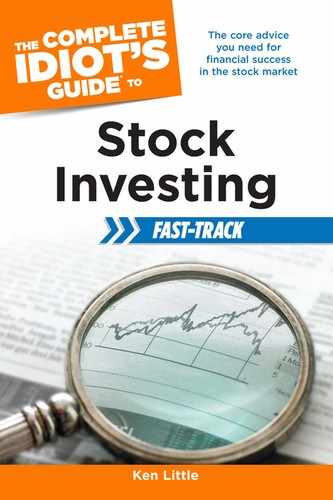Every investor needs an investment strategy; however, you don’t need to be a Wall Street whiz to develop your own. It takes knowing how the basic strategies work, the stocks that are appropriate for that strategy, and an understanding of the risks and potential rewards of investing in stocks. Fortunately, we live in an age when access to important information about companies and stocks is literally at your fingertips. I’ll cover how you can find the information you need to make these decisions in Chapter 3.
You will also find thousands of people on the internet who will be glad to share their strategies with you (for free or not). Unfortunately, many of these strategies are really trading schemes that involve a lot of complicated maneuvers and sophisticated products (selling naked calls, for example). I doubt that many investors who buy into these plans understand the risks involved. You will find many well-meaning people who have an investment strategy they will share for free. Some of these home-grown strategies may actually work, at least in some market conditions. Be careful accepting investment advice from anyone (that’s one reason I don’t recommend an individual stock or any other financial product).
| DEFINITION |
Your investment strategy will work best if you build it yourself using the guidance I provide in this book. This basic strategy will help you begin investing in stocks and if you want to learn more (and you should), there are other books and many websites that you can use. Your investment plan will use one or more of the three basic strategies:
• Investing for growth
• Investing for safety
• Balanced investing
I cover the types of stocks used in these three strategies in Chapter 5.
A growth investing strategy seeks to grow your money (capital) over a long period. The goal is to identify stocks that will provide better than average capital gains (stock price appreciation). In other words, you are looking for growth stocks that can be bought at a reasonable price and with a level of risk that is appropriate for you.
Growth investing can be more risky than other strategies. If you understand the risk associated with different types of growth stocks, you can set your own level of risk. There is much more about growth stocks and risk in Chapter 5.
As the name suggests, investing for safety is a conservative approach to growing your money. An investing for safety strategy is focused more on protecting capital (not losing money) and less on growth. Each investor will need to determine exactly where their comfort level (or risk tolerance, if you prefer) is and formulate an investing strategy that accommodates those guidelines.
As some point, many investors will use an investing for safety strategy for all or part of their goals. A person nearing retirement is an obvious example—the need to preserve capital outweighs the need for growth. Core stocks may appeal to you for reasons outlined in Chapter 5 (in short they represent solid, large companies that are the foundation of many investment strategies). Value stocks, which I discuss in detail in Chapter 5 as well, tend to be less volatile than growth stocks and may be a part of your safety strategy.
| DEFINITION |
Investors, depending on their age and risk tolerance, often choose an investment strategy that is a blend of growth and safety, which I call balanced investing. This investment strategy recognizes the need for growth to reach major financial goals, while providing a degree of safety to offset the turbulence that can accompany growth investing.
A truly balanced investment strategy includes bonds or other fixed-income products and cash in appropriate proportions. However, because this book is about stocks, I’ll stick to examining how investors can balance that portion of the investment formula.
Think of a balanced stock strategy as an engine that propels your investments toward your financial goals. Growth stocks are the accelerator while safety stocks (core and value) are the brakes. As you change the mix between the accelerator and the brakes, you speed up (more growth stocks) or slow down (more safety stocks) your progress. Also as with a car, the faster you go (more growth stocks), the greater the chance for an accident—another way to say more risk. Likewise, if you stomp on the brakes (safety stocks), you may not reach your destination.
That’s as far as I want to go with the car analogy, but it illustrates how growth and safety stocks work together. When you build a balanced investment strategy you decide on the proper mix of growth and safety. As you grow older, and have life-changing events (marriage, children, and so forth), you need to change the mix. Because life is never quite this simple, you will undoubtedly have several investment strategies for your major financial goals. After you understand the various strategies, the different types of stocks, and how they all fit together, you will be ready to shape your strategies.
